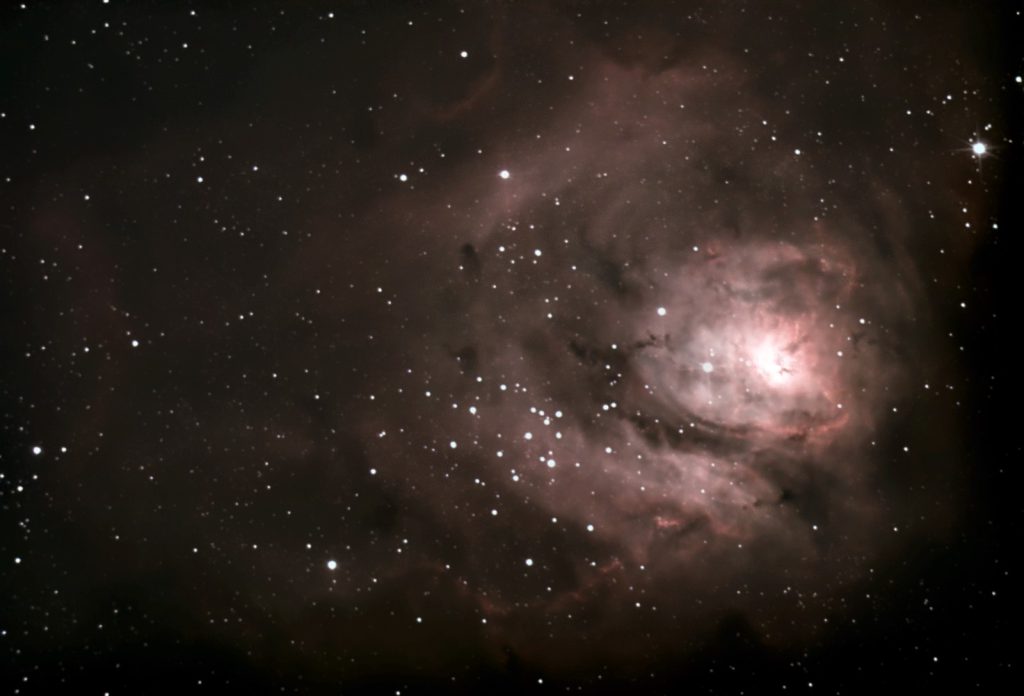M4
Globular cluster in Scorpius
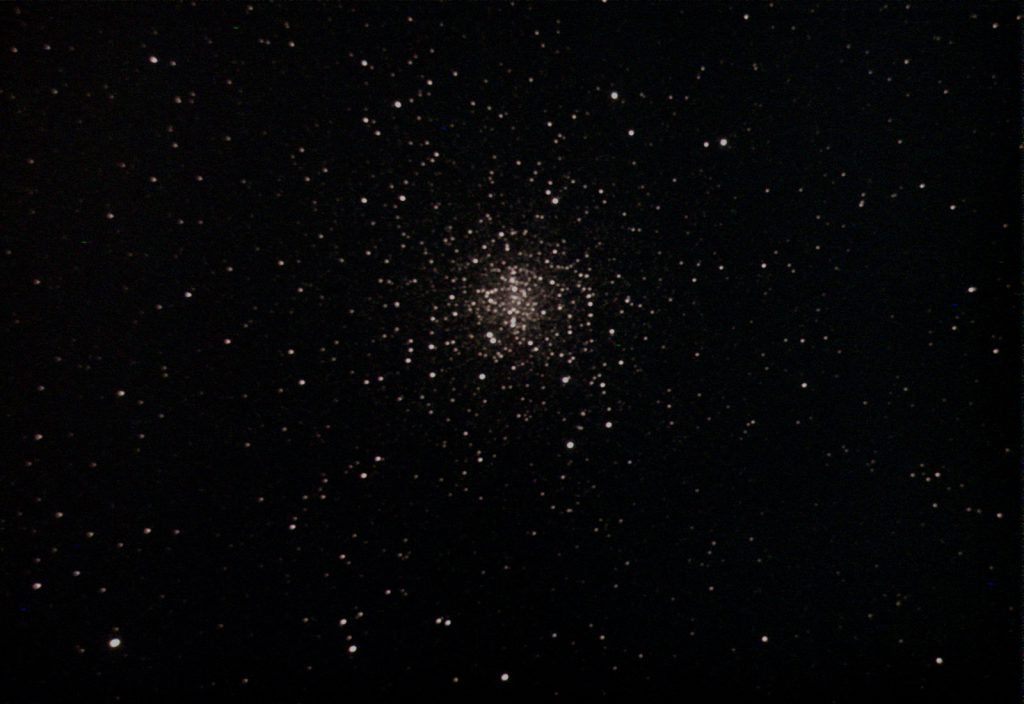
10.1″ f/4.5, Mallincam DS432cTEC with Astronomik UHC filter
Exposure = 3.5 sec, Live Stacked frames = 25, Gain = 63.7 of 250
Compared to other globular clusters, M4 is a very large very loose assembly of stars, appearing about 25 arcminutes across in this view. The stars have a reddish-tinge even with saturation reduced on the Mallincam; according to Burnham’s, M4 is surrounded in a dark nebulosity that effectively reddens their colours. There is a very obvious central bar of stars running vertically through the core. M4 is one of the closest globulars to us, about 7200 light years away, 75 light years across, and listed at 12.2 billion years old.
North at 12 o’clock, East at 9 o’clock
M8
Lagoon Nebula in Sagittarius
10.1″ f/4.5, Mallincam DS432cTEC with Astronomik UHC filter
Exposure = 5-7.5 sec, Live Stacked frames = 20-20 (40 total), Gain = 50 of 250
M8 is a giant H II emission nebula in the Milky Way, about 4000 light years away. Despite lying low in my Bortle 8 skies it still appears quite spectacular. The dark rift separating the bright core of the nebula from the open cluster (NGC 6530) at bottom-left is visible in the eyepiece. Fainter extensions of the nebula reach well toward the left-side of this view and spill over the field of view. The bright star at top-right is 7-Sagittarii, a massive star visible to the naked eye (magnitude 5.37).
North at 11 o’clock, East at 8 o’clock
more images..
M11
Wild Duck Cluster in Scutum
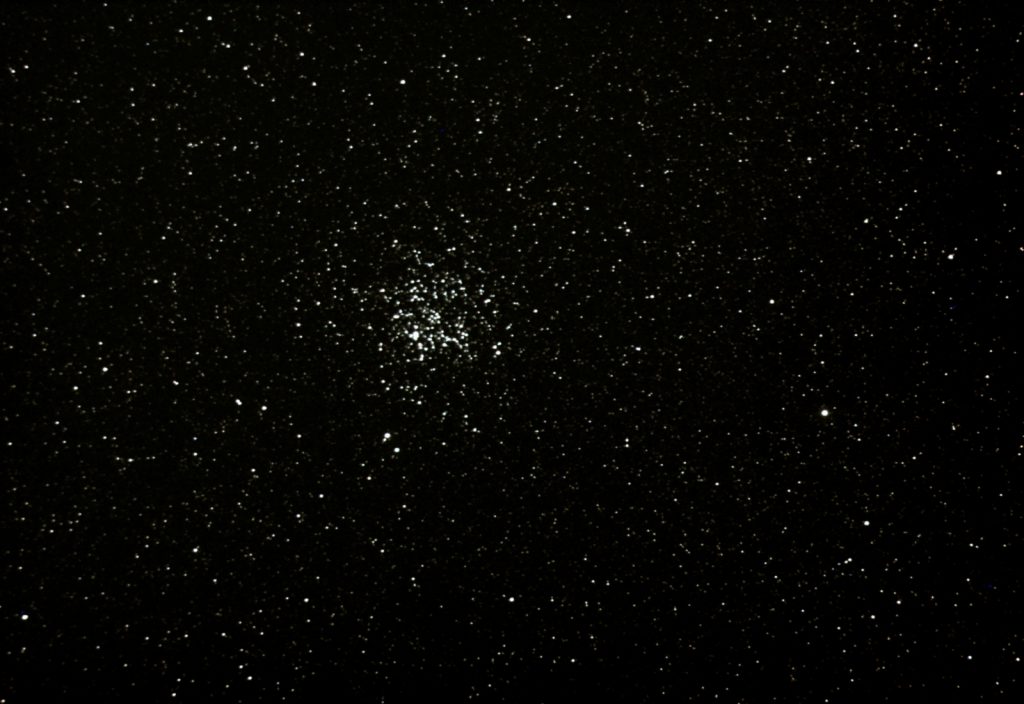
10.1″ f/4.5, Mallincam DS432cTEC with Astronomik UHC filter
Exposure = 5 sec, Live Stacked frames = 20, Gain = 41 of 250
M11 is an unusually rich and dense open cluster containing what appears to be hundreds of stars within about a 15 arcminute space, so dense that it almost looks like a loose globular cluster (see M4 or M12 for example for comparison). The stars have a pale white colour, with one bright star leading the V-shape that points down and to the left (the “duck pack”). M11 is 95 light years across and 6,120 light years away.
North at 11 o’clock, East at 8 o’clock
M19
Globular cluster in Ophiuchus
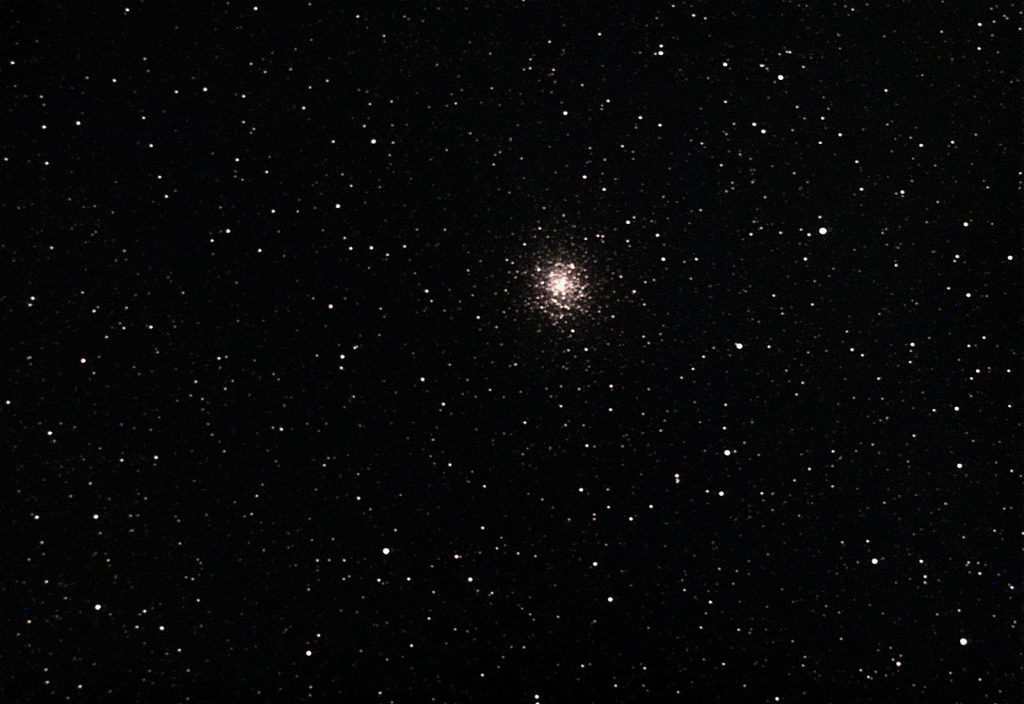
10.1″ f/4.5, Mallincam DS432cTEC with Astronomik UHC filter
Exposure = 5 sec, Live Stacked frames = 15, Gain = 60 of 250
This globular cluster is very compact and oblong in the north-south axis, appearing about 10 arcminutes across in this image. M19 is 28,700 light years away and only 6500 light years from the galactic core.
North at 12 o’clock, East at 9 o’clock
M20
Trifid Nebula in Sagittarius
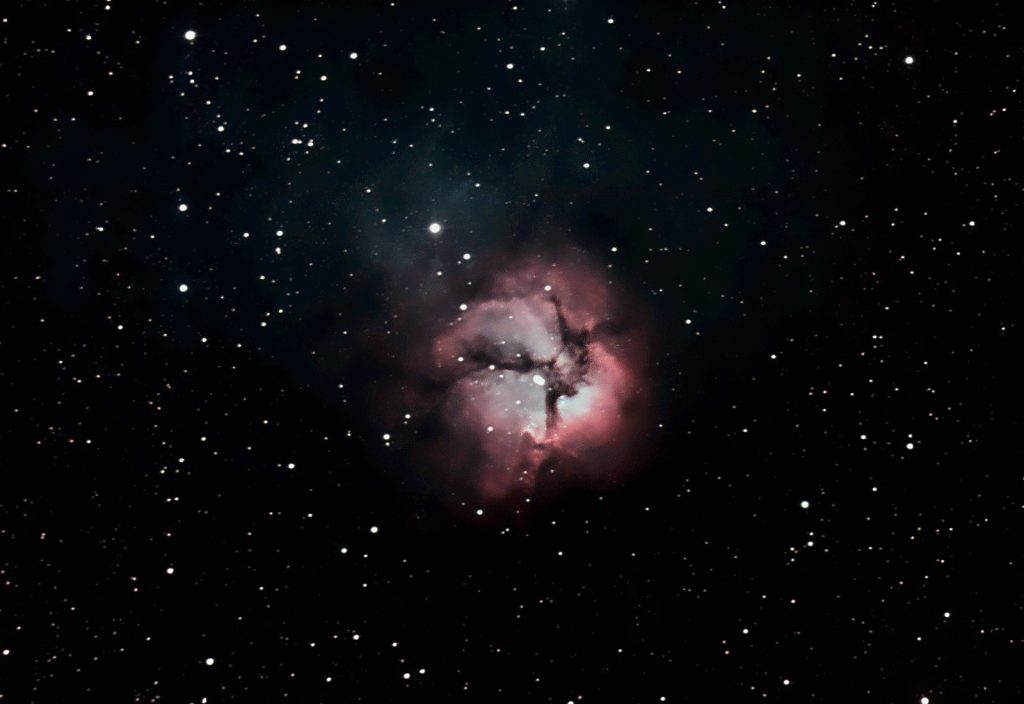
10.1″ f/4.5, Mallincam DS432cTEC with Astronomik UHC filter
Exposure = 15-20-25 sec, Live Stacked frames = 15-25-20 (60 total), Gain = 21 of 250
M20 is a star-forming H II region similar to the Lagoon Nebula a degree and a half to the south. The Trifid shape shows up beautifully even at short exposures, the dark lanes (Barnard 85) in the main red emission portion of the nebula being obvious. These lanes are fairly easily visible in an eyepiece under good skies. The dimmer northern bluish reflection portion of the nebula only appears after multiple stacked frames.
North at 12 o’clock, East at 9 o’clock
NGC 6826
Blinking Planetary in Cygnus
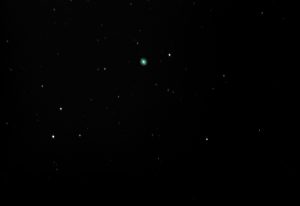
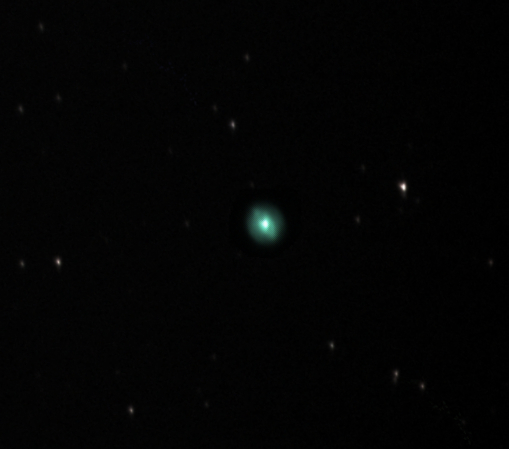
10.1″ f/4.5, Mallincam DS432cTEC with Astronomik UHC filter and 2.5x Powermate
Exposure = 5 sec, Live Stacked frames = 45, Gain = 40 of 250
Also known as Caldwell 15, the Blinking Planetary measures 27 arc seconds by 24. In a low-medium power view such as on the left, the striking and beautiful turquoise colour of the small disk stands out distinctly against the background. At higher power as shown above right, more structure within the disk is obvious; an inclined ring-like structure surrounding the bright central region, all within a circular halo. The tips of the rings poke through the halo on either side. NGC 6826 is about 0.2 light years across and 2000 light years away.
North at 9 o’clock, East at 6 o’clock
NGC 5746
Mini Sombrero Galaxy in Virgo
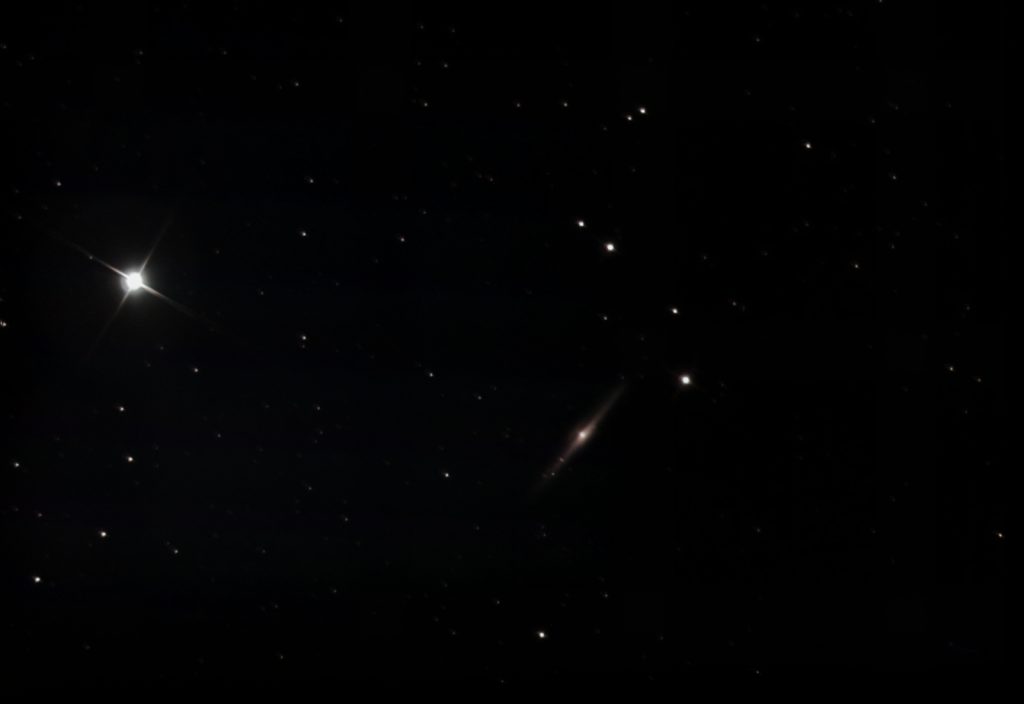
10.1″ f/4.5, Mallincam DS432cTEC with Astronomik UHC filter
Exposure = 15-29 sec, Live Stacked frames = 25-15 (40 total), Gain = 25-40 of 250
Also known as the Blade and Pearl Galaxy, NGC 5746 is a spiral that we see nearly edge-on, appearing about 5 arcminutes long in this image. A least three foreground stars are superimposed on the lower edge. Hints of a dark lane are visible on the north side of the disk. The bright star to the left is 109 Virginis, a 3.7 magnitude star 134.5 light years away that forms one of the “feet” of the constellation Virgo. NGC 5746 is 95 million light years away.
North at 1 o’clock, East at 10 o’clock
NGC 6210
Turtle Nebula in Hercules

10.1″ f/4.5, Mallincam DS432cTEC with Astronomik UHC filter
Exposure = 15 sec, frames = 1, Gain = 13.72 of 250
The small light-green disk of planetary nebula NGC 6210, measuring approximately 25 arcseconds across, is visible in the lower-right corner of this image. The shape of this planetary is slightly oblong in the east-west direction. Distance is 5400 light years away.
North at 11 o’clock, East at 8 o’clock
NGC 6822
Barnard’s Galaxy in Sagittarius
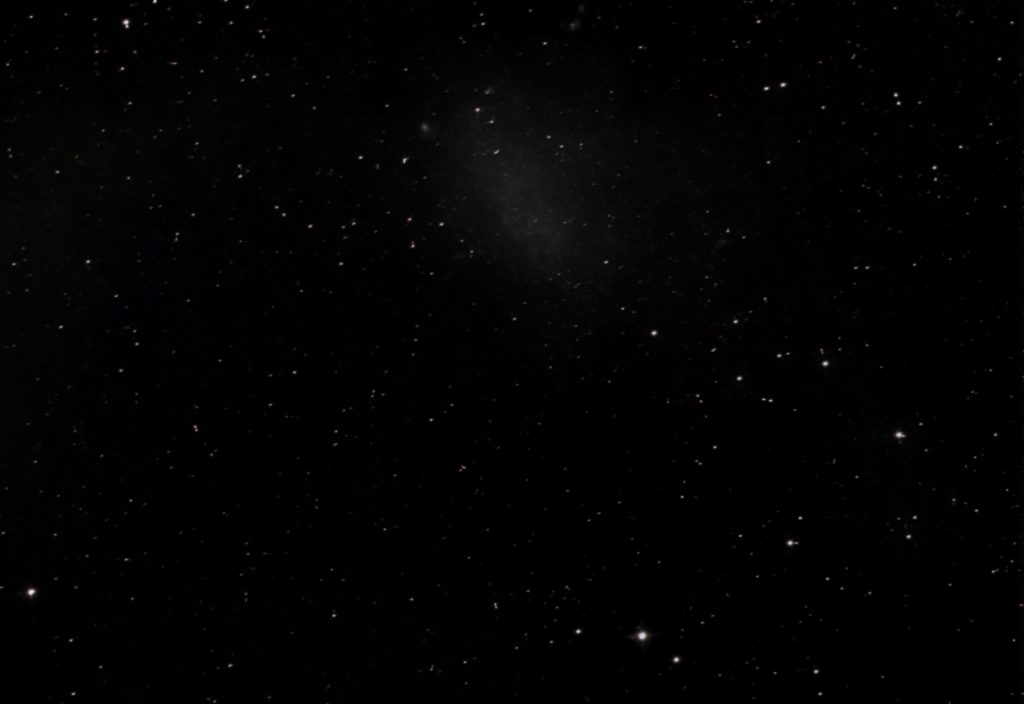
10.1″ f/4.5, Mallincam DS432cTEC with Astronomik UHC filter
Exposure = 13 sec, Live Stacked frames = 60, Gain = 70 of 250
Barnard’s is a dwarf irregular galaxy lying 1.6 million light years away, or two-thirds the distance to the Andromeda Galaxy. It is a member of the Local Group and very similar in size to the Small Magellanic Cloud (7000 light years across), but due to its distance is much smaller and appears very faint in the sky, so faint that I could not immediately see it in the Mallincam. Trusting the location identified in my Nexus DSC, after 15-20 stacks of 13 second exposures it started to appear out of the background sky. Several star-forming regions of ionized hydrogen appear at the top of the image as faint green smudges, including the Bubble Nebula and Ring Nebula very faint at the very top-center right edge of the frame. For comparison see this image from ESO, ALMA.
North at 11 o’clock, East at 8 o’clock
NGC 654
Fuzzy Butterfly Cluster in Cassiopeia
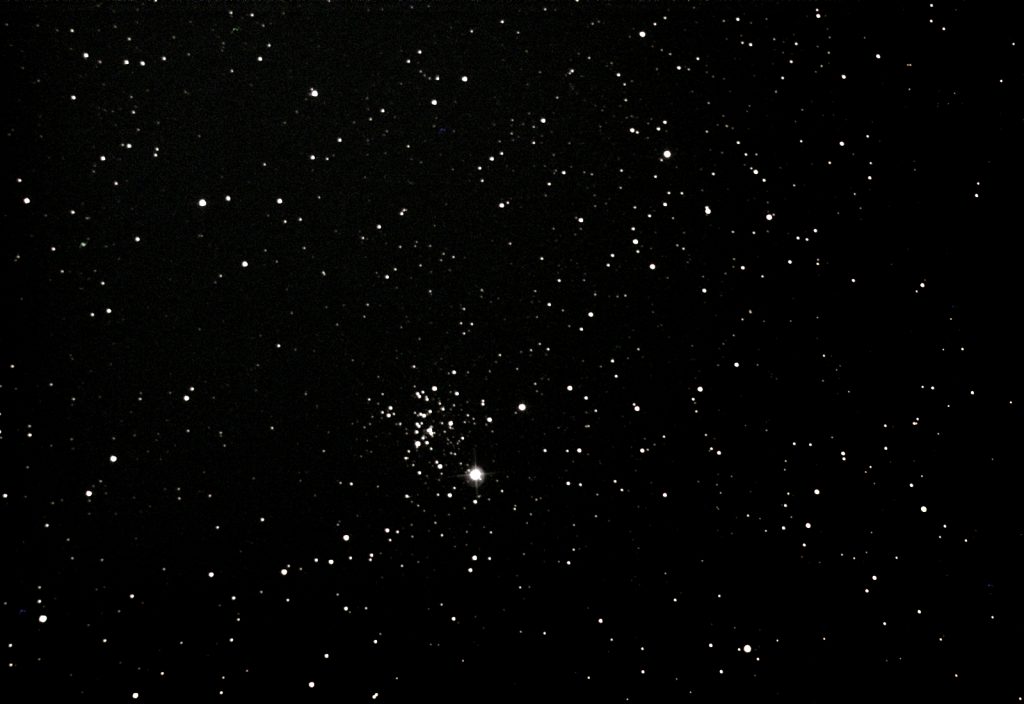
10.1″ f/4.5, Mallincam DS432cTEC with Astronomik UHC filter
Exposure = 2.6 sec, Live Stacked frames = 30, Gain = 72 of 250
A pretty little cluster that stands out well against the background sky with a wedge-shaped core of densely-packed stars and a bright magnitude 7.3 yellow supergiant on the south-east corner. The cluster is relatively far, over 7800 light years away in the Perseus Arm of the Milky Way. North and east of the cluster runs a dark “river” of dust that appears in long-exposure photographs.
North at 9 o’clock, East at 6 o’clock
